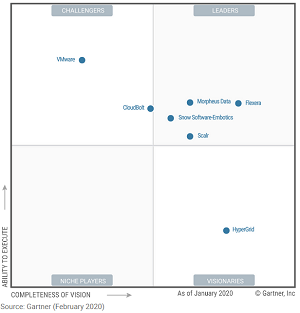News
Report: Cloud Management Platforms Focus on Security, Cost Management
Platforms for managing multicloud -- private/public cloud -- services and resources are emphasizing security and cost management functionality in a growing market, says research firm Gartner in a new Magic Quadrant report.
The study focuses on cloud management platforms (CMPs), which Gartner says provide governance, life cycle management, brokering and automation for managed cloud infrastructure resources across eight required functional areas, of which security and cost management are highlighted in the report.
"Of the eight areas, there is a current emphasis around cost management and security aspects," says the Feb 13 report. "Because of the market dominance of Amazon Web Services (AWS) and Microsoft Azure, and the ongoing need for private cloud and cloud-inspired deployments (i.e., virtualized VMware environments, Kubernetes), the tooling must support at least these environments. Finally, the market consists of independent third-party tooling meant to stand alone as a CMP and not be tethered to other components of a larger tool suite."
The report also notes that Gartner has observed growing demand for using CMP solutions to "Apply governance that allows the enforcement of cloud service standards where the key areas of governance are around cost management and security."
In view of that observation, Gartner said enterprises should look to "Combine CMP functionality with cloud-native tooling, choosing where a CMP makes sense (for example, cost management, resource optimization, governance and security) versus where it doesn’t (for example, provisioning and orchestration, monitoring and analytics)."
The research firm offers plenty of other advice in the report, which lists Flexera, Morpheus Data, Snow Software-Embotics and Scalr as "Leaders," while VMware and CloudBolt are in the "Challengers" section and HyperGrid was the sole "Visionary."
 [Click on image for larger view.] Magic Quadrant for Cloud Management Platforms (source: Gartner).
[Click on image for larger view.] Magic Quadrant for Cloud Management Platforms (source: Gartner).
For the CMP market in general, Gartner forecasts that by 2025, the percentage of enterprises using multifaceted cloud governance tools will be more than 70 percent, compared to less than 10 percent in 2020.
The firm sees the CMP space as part of the larger cloud management platform and tools (CMPT) market, which is expected to continue growing at an estimated 20 percent compound annual growth rate (CAGR) through 2022. The CMP market will grow more slowly. "This growth is, and will continue to be, hindered by more focused tools around key use cases (for example, governance) and competition from native services," Gartner said.
In addition to the advice tip mentioned above, Gartner advised enterprises to:
- Realize that more than 90 vendors offer cloud management functionality (that is, a tool that satisfies at least one or a few of the functional cloud management areas). However, a smaller number offers CMP functionality (that is, a solution that addresses most of the required cloud management functionality). This wide diversity makes it tough to map your requirements to the right product. You need to define your requirements and select only products that meet your needs. Don’t immediately assume you need a CMP if a single or limited function cost management or security tool would be better.
- Anticipate a wide mix of competitive pricing models. Model the potential pricing against your future cloud deployment plans and compare against competitive offerings.
- Deeply analyze the architecture of potential vendors. Most have a common architecture that provides multiple functions. Some are moving to more modular offerings in which you are charged only for functions used (very desirable). Some vendors are integrating different products (many of which have been acquired), with varying degrees of success. Some provide a limited set of core capabilities and then offer integration points for best-in-class products. The latter can complicate expectation management, procurement, implementation, training and ongoing operational maintenance.
- Choose a stand-alone product that integrates with your selected CMP. Cost and expense management is becoming “table stakes.” This, along with provisioning and orchestration, is often stressed by vendors and tends to be a strength area for many. It is less so for cloud migration, backup, disaster recovery or security.
- Anticipate needing to devote time and money against out-of-the-box integration coverage. It continues to improve. However, it remains variable across CMP solutions.
- Be on the lookout and assess both broad and deep CMP functionality requirements. The broader the set of capabilities a CMP covers, the higher the risk of providing shallow functionality in each capability. Point solutions achieve deeper functionality due to a narrower focus.
Offering a competitive outlook in the space, Gartner said, "CMP vendors will continue to face intense competition on many fronts. The CMP proposition is that it is too tough to integrate the various cloud management functions. Niche cloud management vendors argue that enterprises need best-in-class functionality, which they provide. Both narratives will coexist for a while longer, though the latter appears to be winning.
"However, many CMP vendors are beginning to scale back and focus on specific enterprise requirements, such as inventory and classification, governance, financial management, workload optimization and security. At the same time, they will interface with best-in-class products (third-party and native-cloud) for other functions. Some are looking to add SaaS management capabilities (as this market is mostly focused on IaaS/PaaS) and/or adding software and hardware asset management."
The for-pay report is offered in a licensed-for-distribution PDF available for download, upon providing registration information, by at least one of the showcased vendors.
About the Author
David Ramel is an editor and writer at Converge 360.